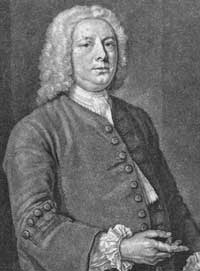William Caslon
William Caslon (* 1692 in Cradley in the county of Worcestershire , † 23. January 1766 in Bethnal Green , a suburb of London ) was a British engraver and type designer , the same font Caslon developed. His work greatly influenced John Baskerville . He founded the Caslon type foundry in London.
In 1706 William Caslon began an apprenticeship as an engraver. In 1716 he opened a company in London that engraved weapons and sharpened tools for bookbinders . This brought him into contact with the printing industry. In 1721 he was commissioned to produce Arabic scripts for the Society for Promoting Christian Knowledge . After support and encouragement from the printer William Bowyer (1699–1777), he opened his own type foundry in 1725. Bowyer was also the first to use the antiqua cut by William Caslon in 1722 for the publication of the writings of the lawyer John Selden . In 1734 Caslon brought out his first handwriting sample sheet with a total of 47 typefaces he had produced.
The legibility and the special expression of his typefaces meant that the most famous printers in England at the time particularly appreciated him and his work. In addition, William Caslon managed through the quality of his typefaces to make the English printers independent of the imports of the Dutch type foundry, who were considered leading at the time. The Caslon developed by him was often used in England for this reason. However, it soon found recognition in America too. In 1776 the first printing of the US Declaration of Independence was carried out with the Caslon. At the end of the 18th century, interest in William Caslon's writings initially declined. However, they were rediscovered in the middle of the 19th century. In 1940 George Bernard Shaw demanded that all of his books be printed in the Caslon.
After 1735 Caslon's eldest son William II (1720–88) joined the company and around 1742 he became a business partner. Although he lacked his father's great skills, he maintained the company's reputation and, with the help of his wife Elizabeth, did it skillfully.
With the death of William II in 1788, the foundry "Caslon & Son" was divided among the heirs.
The founder's great-grandson, William Caslon IV, sold the foundry to Blake, Garnett & Co. in 1819. In 1837 the foundry, which was still called Caslon, became part of Stephenson, Blake & Co. in Sheffield .
In 1916 Frederic Goudy sold 8 new typefaces to the Caslon type foundry in London.
Caslon's type foundry existed for over 200 years.
Web links
- At The Caslon Letter Foundry August 5, 2013
- An exciting article about William Caslon recalls London's first great typeface designer
- Biography William Caslon
- William Caslon in nndb (English)
- William Caslon and contemporaries
- William Caslon (1692-1766) in the National Portrait Gallery - mezzotint, (1740) by John Faber Jr, after a painting by Francis Kyte
literature
- Johnson Ball: William Caslon, master of letters. The ancestry life and connections of England's foremost letter-engraver and type-founder. Roundwood Press, Kineton 1973, ISBN 0-900093-13-7 .
- Henry Caslon: Specimen of Printing Types. Published 1841 - Sample Book
- Ornaments and borders - page 273 ff
- Ships and railways and chessboards - page 295 ff
Individual evidence
- ^ William Caslon in 2014 Encyclopædia Britannica, Inc.
- ↑ http://www.stavendamm.de/schrift/caslon-d.htm ( page no longer available , search in web archives ) Info: The link was automatically marked as defective. Please check the link according to the instructions and then remove this notice. Example of modern advertising on the Internet
- ^ Caslon type foundry
| personal data | |
|---|---|
| SURNAME | Caslon, William |
| BRIEF DESCRIPTION | British engraver and type designer |
| DATE OF BIRTH | 1692 |
| PLACE OF BIRTH | Cradley |
| DATE OF DEATH | January 23, 1766 |
| Place of death | Bethnal Green |

